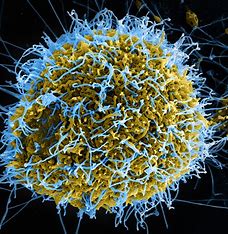Introduction
Ebola virus disease (EVD), commonly known as Ebola, is a severe and often fatal illness caused by the Ebola virus. It has the potential to cause outbreaks with high mortality rates. This article provides an overview of Ebola, including its transmission, symptoms, prevention strategies, and available treatments.
Transmission and Risk Factors
a. Direct Contact: Ebola is transmitted through direct contact with the bodily fluids (such as blood, saliva, urine, feces, vomit, and semen) of an infected person who is symptomatic or has died from the disease. Close contact with infected individuals or their contaminated belongings poses a higher risk.
b. Animal Reservoirs: The virus is believed to originate from bats, and other nonhuman primates can also carry and transmit the virus to humans through contact with their bodily fluids or consumption of their meat.
c. Healthcare Settings: Healthcare workers and individuals providing care to Ebola patients are at an increased risk of contracting the virus if proper infection control measures are not implemented.
Symptoms and Clinical Manifestations
a. Incubation Period: The incubation period of Ebola ranges from 2 to 21 days, during which individuals may not exhibit any symptoms.
b. Early Symptoms: The initial symptoms of Ebola include fever, fatigue, muscle pain, headache, and sore throat. These are followed by vomiting, diarrhea, rash, impaired kidney and liver function, and, in some cases, internal and external bleeding.
c. Disease Progression: Ebola can progress rapidly, leading to severe dehydration, organ failure, and in some cases, death. However, not all individuals infected with the virus develop severe symptoms, and some may recover with proper medical care.
Prevention Strategies
a. Infection Control Practices: Implementing strict infection control measures in healthcare settings is crucial to prevent the spread of Ebola. This includes the use of personal protective equipment (such as gloves, masks, gowns), proper disinfection of surfaces, safe handling of contaminated materials, and adherence to proper burial practices.
b. Safe Burial Practices: Ensuring safe and dignified burials for individuals who have died from Ebola is essential to prevent further transmission. This involves proper handling of the deceased and avoiding direct contact with their bodily fluids.
c. Community Engagement: Raising awareness about Ebola, its transmission, and preventive measures within affected communities plays a vital role in controlling outbreaks. This includes promoting hygiene practices, early reporting of suspected cases, and active participation in response efforts.
d. Travel Restrictions: Implementing travel restrictions and monitoring individuals traveling from areas experiencing Ebola outbreaks can help prevent the international spread of the virus.
Treatment and Management
a. Supportive Care: There is no specific antiviral treatment for Ebola; therefore, supportive care is the mainstay of management. This includes maintaining fluid and electrolyte balance, providing pain relief, treating complications (such as secondary infections), and addressing specific symptoms.
b. Experimental Treatments: Experimental therapies, such as monoclonal antibody treatments and antiviral drugs, have shown promising results in treating Ebola. These treatments are typically used under controlled research conditions or during outbreaks as part of clinical trials.
c. Vaccination: An Ebola vaccine has been developed and approved for use. It has shown efficacy in preventing Ebola infection and is recommended for individuals at risk, including healthcare workers and those living in or traveling to areas with active Ebola transmission.
Conclusion
Ebola is a highly contagious and dangerous viral disease, with the potential for devastating outbreaks. Timely identification, effective infection control practices, community engagement, and access to supportive care are crucial in containing and managing Ebola outbreaks. Ongoing research, vaccine development, and preparedness efforts are essential to prevent future epidemics and protect public health. By understanding the transmission dynamics and implementing preventive measures, we can work towards mitigating the impact of Ebola and safeguarding the well-being of affected communities.

